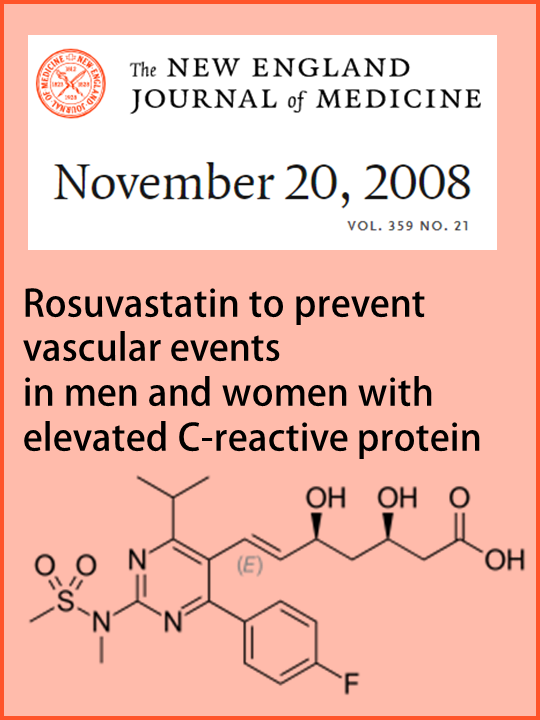Rosuvastatin to prevent vascular events in men and women with elevated C-reactive protein
New England Journal of Medicine
Volume 359, Issue 21, 20 November 2008, Pages 2195-2207 l DOI: 10.1056/NEJMoa0807646
Paul M Ridker, M.D., Eleanor Danielson, M.I.A., Francisco A.H. Fonseca, M.D., Jacques Genest, M.D., Antonio M. Gotto, Jr., M.D., John J.P. Kastelein, M.D., Wolfgang Koenig, M.D., Peter Libby, M.D., Alberto J. Lorenzatti, M.D., Jean G. MacFadyen, B.A., Børge G. Nordestgaard, M.D., James Shepherd, M.D., et al., for the JUPITER Study Group*
Abstract
BACKGROUND
Increased levels of the inflammatory biomarker high-sensitivity C-reactive protein predict cardiovascular events. Since statins lower levels of high-sensitivity C-reactive protein as well as cholesterol, we hypothesized that people with elevated high-sensitivity C-reactive protein levels but without hyperlipidemia might benefit from statin treatment.
METHODS
We randomly assigned 17,802 apparently healthy men and women with low-density lipoprotein (LDL) cholesterol levels of less than 130 mg per deciliter (3.4 mmol per liter) and high-sensitivity C-reactive protein levels of 2.0 mg per liter or higher to rosuvastatin, 20 mg daily, or placebo and followed them for the occurrence of the combined primary end point of myocardial infarction, stroke, arterial revascularization, hospitalization for unstable angina, or death from cardiovascular causes.
RESULTS
The trial was stopped after a median follow-up of 1.9 years (maximum, 5.0). Rosuvastatin reduced LDL cholesterol levels by 50% and high-sensitivity C-reactive protein levels by 37%. The rates of the primary end point were 0.77 and 1.36 per 100 person-years of follow-up in the rosuvastatin and placebo groups, respectively (hazard ratio for rosuvastatin, 0.56; 95% confidence interval [CI], 0.46 to 0.69; P<0.00001), with corresponding rates of 0.17 and 0.37 for myocardial infarction (hazard ratio, 0.46; 95% CI, 0.30 to 0.70; P=0.0002), 0.18 and 0.34 for stroke (hazard ratio, 0.52; 95% CI, 0.34 to 0.79; P=0.002), 0.41 and 0.77 for revascularization or unstable angina (hazard ratio, 0.53; 95% CI, 0.40 to 0.70; P<0.00001), 0.45 and 0.85 for the combined end point of myocardial infarction, stroke, or death from cardiovascular causes (hazard ratio, 0.53; 95% CI, 0.40 to 0.69; P<0.00001), and 1.00 and 1.25 for death from any cause (hazard ratio, 0.80; 95% CI, 0.67 to 0.97; P=0.02). Consistent effects were observed in all subgroups evaluated. The rosuvastatin group did not have a significant increase in myopathy or cancer but did have a higher incidence of physician-reported diabetes.
CONCLUSIONS
In this trial of apparently healthy persons without hyperlipidemia but with elevated high-sensitivity C-reactive protein levels, rosuvastatin significantly reduced the incidence of major cardiovascular events. (ClinicalTrials.gov number, NCT00239681.)



